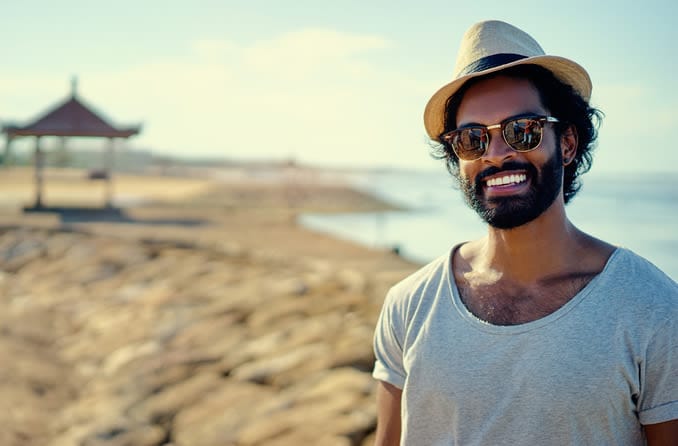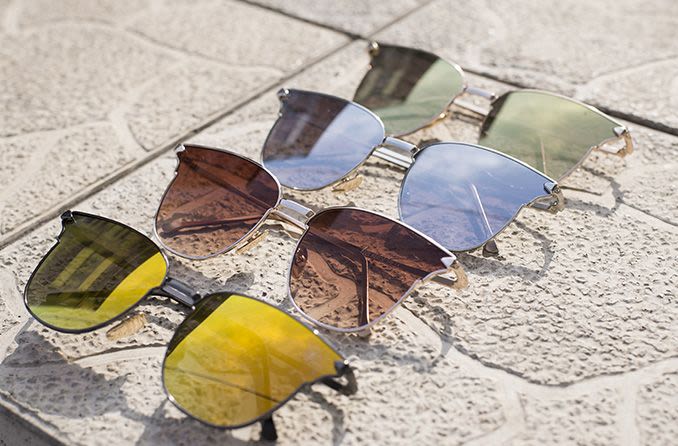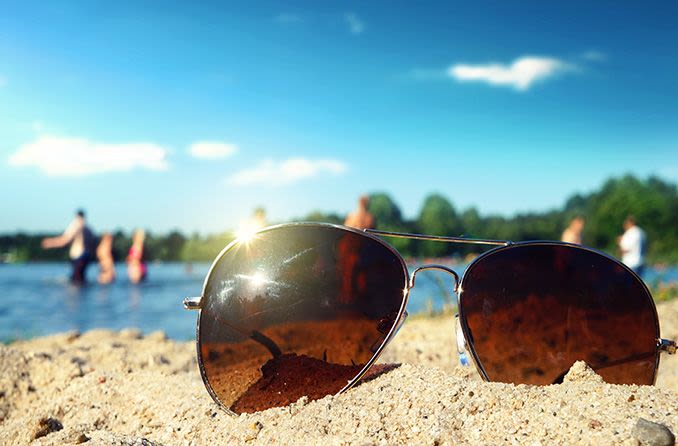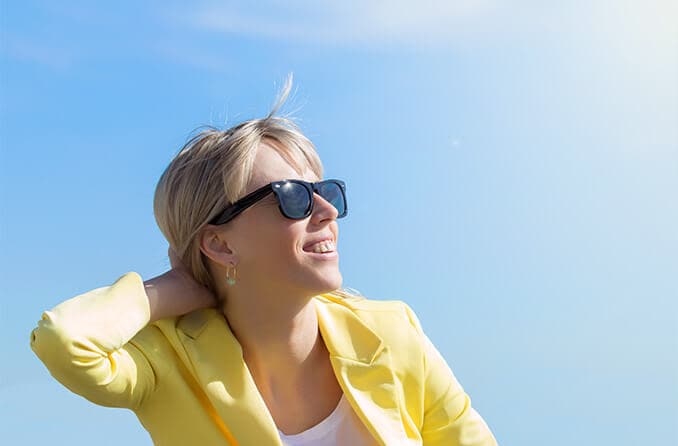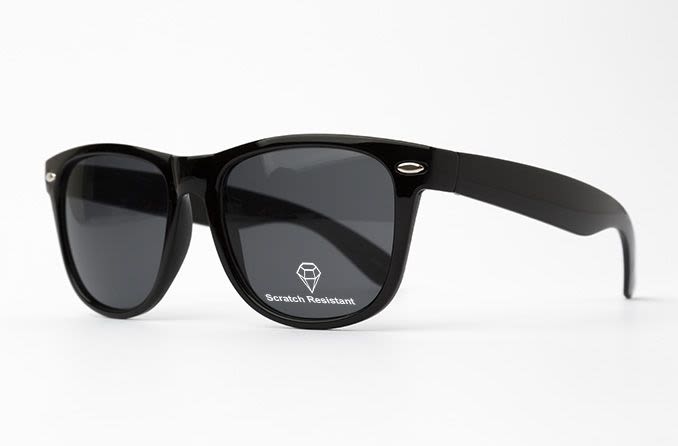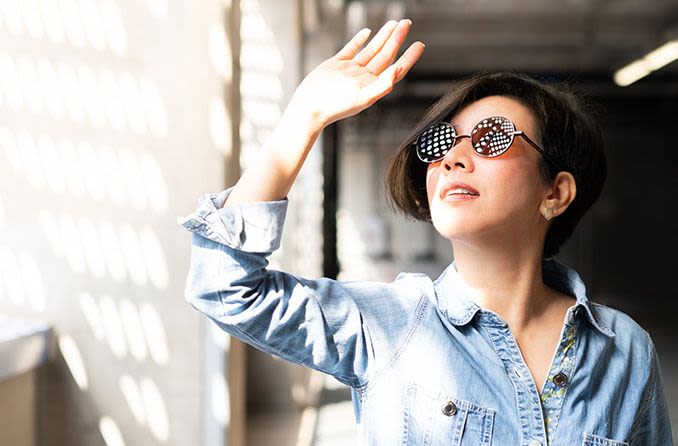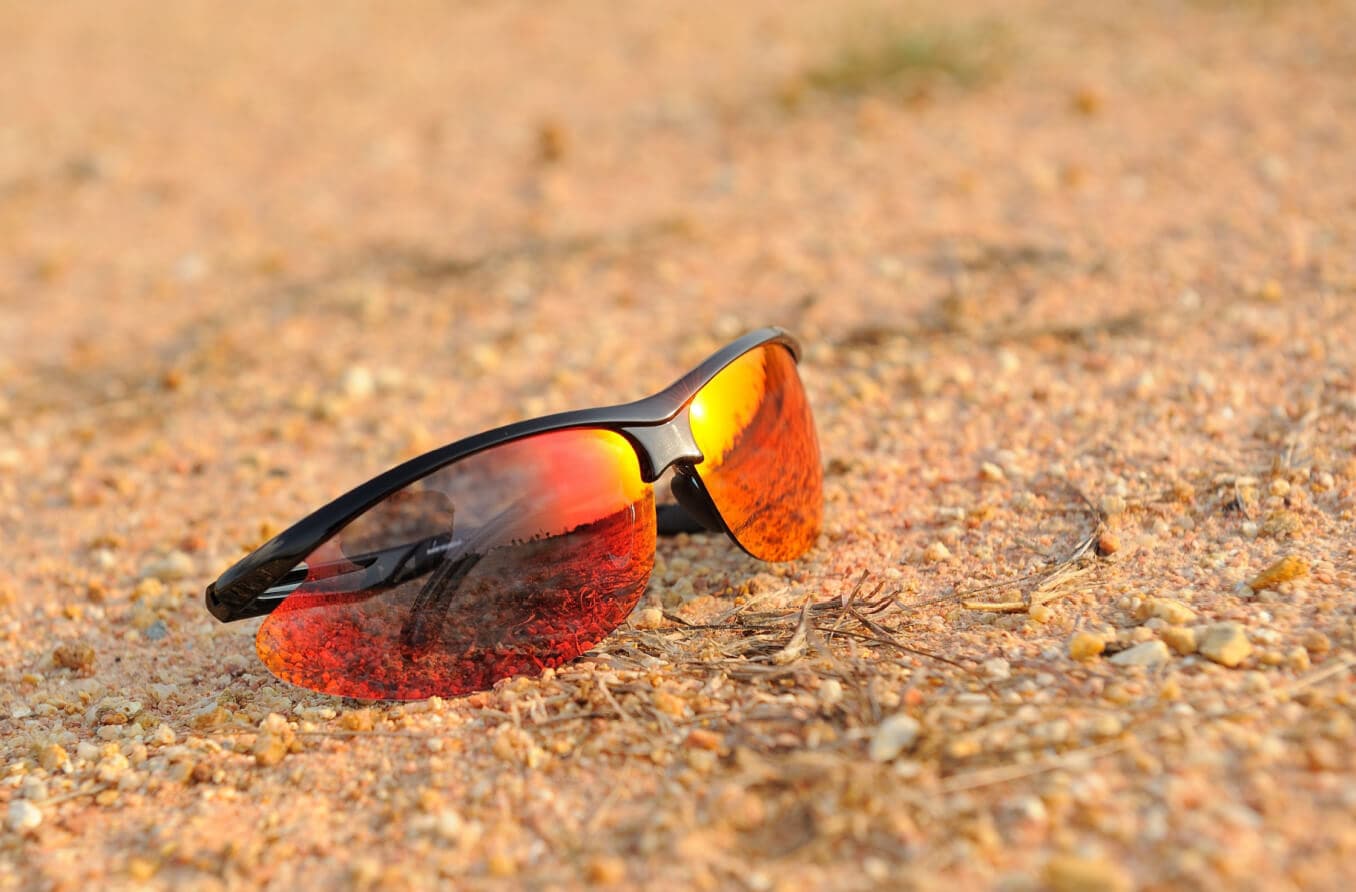Mirrored sunglasses have a thin metallic layer on the outside of the lenses that reflects glare away from the sunglasses rather than letting it in, reducing the amount of light entering the eyes. This makes them like one-way mirrors when observed from the outer side of the sunglasses. The lenses may look opaque due to the reflective coating, but they do let enough light through to help you see clearly with minimal eyestrain.
They are a great option for outdoor activities in very bright conditions where glare is a concern — for example, snow sports on a sunny day — as they can protect your vision by bouncing light rays off the lenses and away from your eyes.
Of course, protection from harmful ultraviolet (UV) light should be your first priority when choosing any type of sunglasses. From there, you’ll want to consider any safety and performance needs for your chosen outdoor activity — if you’re playing a sport that requires concentration, for instance, you want optimal vision — before tackling frame styles and the shape and color of the lenses.
UV protection
According to the American Academy of Ophthalmology, UV light can harm your eyes and potentially cause cataracts, eye cancers and growths such as pterygium. Without proper protection from light rays that reflect off surfaces like snow, sand or water, photokeratitis (a corneal sunburn commonly called snow blindness) can also occur with surprising speed.
Wearing sunglasses whenever you’re outdoors during the daytime is the best solution for protecting your eyes. It’s just as important to wear your shades when skies are overcast, as UV rays can penetrate cloud cover — meaning you can still experience glare from light bouncing off reflective surfaces, even if your surroundings are dimly lit.
Be sure to select sunglasses, including prescription sunglasses, that offer 100% UV or UV400 protection. It’s important to note that darker lenses don’t necessarily block more UV rays — the UV-protective chemicals are added to the lens during the manufacturing process, so they have nothing to do with lens color or degree of darkness.
How do you test the quality of non-prescription lenses? First, close one eye and hold the sunglasses at a comfortable distance. Scan a rectangular tile or lines on the floor by moving the glasses slowly from side to side and up and down. If the lines stay straight and don't distort, you know you have a good quality pair of glasses.
Why mirrored sunglasses?
As with all sunglasses, mirror shades can help protect your eyes from the sun’s damaging rays. Unlike many other types, though, these feature a special anti-reflective coating on the outside of the lenses that bounce light rays and glare away from the sunglasses and your eyes.
Other benefits include durability and style — many users consider them a fashion statement. These sunglasses are also an excellent option for certain sports and outdoor activities, particularly those involving snow, water or sand.
Durability
The thin metal layer offers a higher level of durability in your mirrored sunglasses. However, they do tend to scratch and need a lot more care. Some brands come with an additional scratch-resistant layer. If not, this can be applied at a later stage, which is certainly worth considering if you use your sunglasses frequently. This extra non-scratch layer also serves to strengthen the sunglasses a little more.
Mirror sunglasses and sports
Mirror lens sunglasses are a great option for skiing, watersports, sandboarding and flying sports such as microlighting and gliding, where glare is a big factor that can affect both your efficiency/performance and safety.
Other activities like hiking and cycling can also involve spending hours in the sun. It’s important to wear the correct eyewear, even if it’s early in the morning, as the UV rays are already doing their work.
Keep in mind that if you’re wearing a hat, you may not be affected by direct sunlight from above, but you can still experience harmful glare from surrounding surfaces such as water and rocks. Mirror sunglasses are an excellent way to protect your eyes from such reflected light rays.
SEE RELATED: Choosing the best sunglasses for an active lifestyle
Mirror sunglasses and driving
Mirror sunglasses reduce glare — from the road, your car hood and other cars — better than sunglasses with standard, non-reflective lenses. They’re a fine option for driving and help minimize eyestrain. Polarized sunglasses also do a great job of protecting your eyes from glare. But they can react with the tempered glass of some car windows, distorting the light coming in; if this happens, you may see patterns, swirls of color or even blind spots. Mirrored sunglasses, meanwhile, avoid this significant danger.
Mirror vs. polarized lenses
Polarized sunglasses and those with mirrored lenses can both provide additional protection from harmful rays, though there are a few differences to keep in mind.
While polarized lenses reduce glare quite substantially, as mentioned, they can react with tints in some car windows and create potentially unsafe visual distortion or blind spots.
Mirror sunglasses, on the other hand, have an additional layer that make them more durable. They also reduce glare without reacting to windshield tints, making them a better option for driving.
Mirrored polarized sunglasses are available, but it might be wiser to buy one pair of each and wear whichever one is most appropriate to your environment. For example, mirrored polarized glasses are not going to work for driving.
Choosing a color for mirror reflective sunglasses
There are a multitude of options when it comes to color and style. The color of the reflective layer on your sunglasses is not necessarily the same as your lens color — if you’re wearing blue mirrored sunglasses, for instance, that doesn't mean that you’ll see the world in brilliant hues of blue. It’s important to make an informed decision when choosing a lens color, as this can have a significant impact on how you perceive your surroundings.
In other words, there is more to the color of your lenses than pure aesthetics. Different lens colors serve different purposes, and depending on the environment, the tint of your sunglasses can enhance your depth perception and reduce eye fatigue.
Darker colors are ideal for everyday use and most sporting activities. They cut through glare and reduce eyestrain considerably.
- Brown: This lens color can enable you to see a wider range of colors and contrasts. Brown shades reduce glare without dimming your vision, even in overcast conditions.
- Grey: Grey lenses reduce glare and help maintain depth-perception. They are perfect for activities that require precise eyesight.
- Green: Another neutral shade, green lenses offer minimal color distortion and enhanced light contrast. Green lenses brighten shadows and minimize glare, making them a good choice for bright conditions.
- Yellow: Yellow or gold lenses are a good choice when it comes to cloudy and dull weather, as they provide better depth perception and a good contrast range for improved visibility. On bright days, however, yellow distorts color and doesn't offer much glare protection.
- Pink/rose: Rose-colored lenses are popular for snow sports as they offer a brighter, clearer view of the surrounding environment, regardless of whether the sun is shining or not.
Choice of frames
Once you’ve decided on a shade and whether you’re getting that extra scratch-resistant layer, it’s time to pick a frame for your mirrored sunglasses.
For athletic sunglasses, shape and style can crucially impact your comfort and eye protection — and even make a major difference in your performance. The aviator-style's teardrop shape helps protect against the glare of sea, sand and snow below you, while wraparound frames block rays that would normally sneak in from the sides of your sunglasses.
If you are doing serious snow skiing or water sports, you might want to consider wearing protective goggles. But if you’re looking for standard mirror sunglasses, go bigger for better protection.
Mirrored or not?
As mentioned earlier, mirrored sunglasses offer a range of benefits, including glare reduction, durability and style — you can even customize your sunglasses to get any mirror and tint combination you’d like. They’re also a good option for many sports and activities, especially those involving water, snow and sand.
One disadvantage? Mirror shades are more susceptible to scratching and need extra care, though you can opt to add a scratch-proof finish to help remedy that.
They can also be more expensive. So, unless you can afford more than one pair of sunglasses, your decision about the type of lenses — reflective or not — as well as tints and frame styles should start with the option that protects your eyes and vision health.
It’s always a good idea to ask your eye doctor or optician for advice, as they can help you choose sunglasses best suited for your specific needs.

